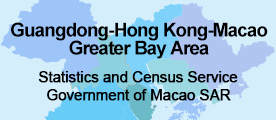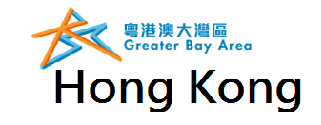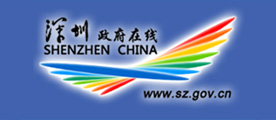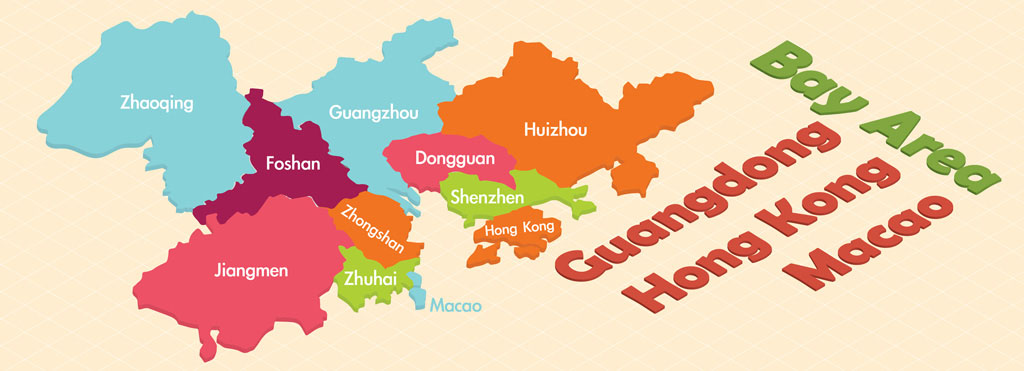Summary
The Guangdong-Hong Kong-Macao Greater Bay Area (Greater Bay Area in short) includes the two Special Administrative Regions of Hong Kong and Macao as well as Guangzhou, Shenzhen, Zhuhai, Foshan, Huizhou, Dongguan, Zhongshan, Jiangmen and Zhaoqing in Guangdong province. The Area covering a total area of 56,000 square meters had a combined population of about 70 million at the end of 2017.
The Outline Development Plan for Guangdong-Hong Kong-Macao Greater Bay Area aims at, through the development of the aforesaid Special Administrative Regions and nine cities in the Pearl River Delta, further deepening the cooperation between Guangdong, Hong Kong and Macao, facilitating in-depth integration within the region by making full use of the composite advantages of the three places and promoting coordinated economic development in the Area, with a view to developing an international first-class bay area ideal for living, working and travelling.
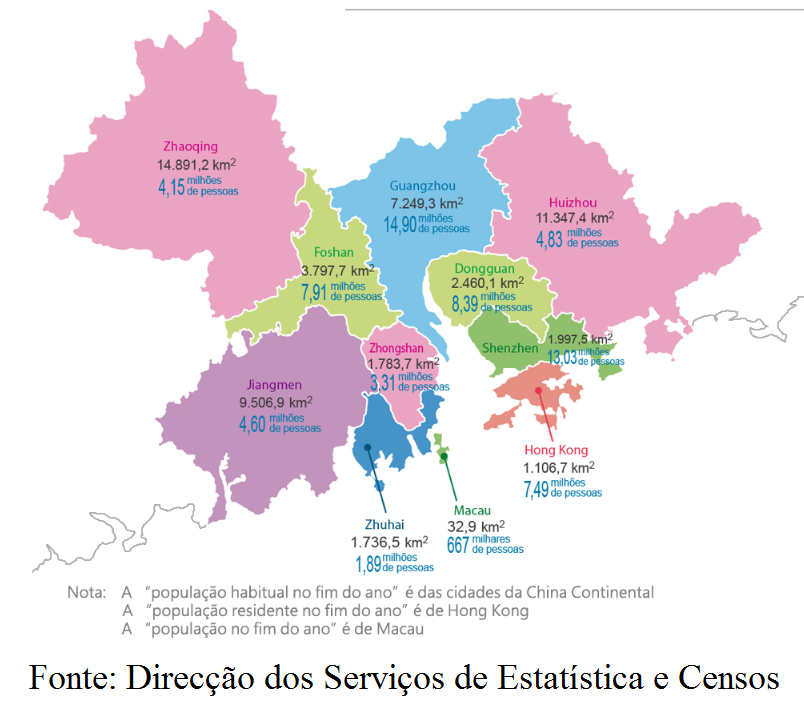
Full Text of Outline Development Plan for the Guangdong-Hong Kong-Macao Greater Bay Area
(Only the Chinese version is available.)
(cited from Macao Policy Research and Regional Development Bureau)
Macao content covered in 49 places in the Outline
(Only the Chinese version is available.)
(cited from Macao Policy Research and Regional Development Bureau)
Macao’s Positioning in Greater Bay Area and Development Directions
Strategic positioning is essentially important to regional planning. Macao has been positioned as a centre and platform in terms of its development, according to the Five-Year Development Plan of the Macao Special Administrative Region (2016-2020) and the country’s “13th Five-year Plan” mentions its support for Macao’s transformation into a world tourism and leisure centre as well as a commercial and trade cooperation service platform between China and Portuguese-speaking countries, in order to promote the city’s moderate economic diversification for its sustainable development. The city’s positioning is further developed with more details added in the Outline Development Plan for Guangdong-Hong Kong-Macao Greater Bay Area. Meanwhile, given the cultural diversity of the Greater Bay Area and in the interest of the construction of the “Belt and Road” route, it has been put forth in the Outline that Macao should establish itself as an exchange and cooperation base of diverse cultures dominated by Chinese culture. In sum, Macao has been positioned as a centre, platform and base for its long-term development. In other words, the city serves as a gateway to bring in tourists from across the world and helps enterprises to go global. For more relevant information, see Talks on Greater Bay Area – Academics’ Views. (Only Chinese version is available.)
Data and Information about Greater Bay Area
Comparison between Guangdong-Hong Kong-Macao Greater Bay Area and Three Other Bay Areas – Basic Economic Data (Source: Legislative Council Secretariat, Hong Kong)
| Comparison Indicators | Guangdong-Hong Kong-Macao Greater Bay Area | San Francisco Bay Area | New York Metropolitan Area | Tokyo Bay Area |
|---|---|---|---|---|
| Land Area (km2) | 56,094 | 17,887 | 21,479 | 36,899 |
| Population (10,000) | 7,116 | 782 | 1,998 | 4,418 |
| GDP1(USD 100 million)2 | 16,419.7 | 8,375.43 | 17,177.13 | 17,742.34 |
| Real GDP Growth Rate (%) | 5.9 | 4.73 | 1.33 | 2.14 |
| GDP Per Capita (USD)2 | 23,075 | 107,1783 | 85,9743 | 40,1634 |
| Air Passenger Traffic (10,000 persons) | 21,490.0 | 8,570.7 | 13,806.8 | 12,556.9 |
| Air Freight and Airmail Volume (10,000 tonnes) | 832.3 | 123.4 | 221.3 | 349.2 |
| Port Cargo Throughput (10,000 TEU) | 7,441.9 | 242.1 | 718.0 | 824.23 |
| Share of Tertiary Sector in GDP (%) | 66.1 | 72.13 | 83.53 | 77.04 |
- 1 calculated at the then current market prices
- 2 translated at the average exchange rates for the then current year
- 3 data of 2017
- 4 data of 2015
For more statistical data about the Area, refer to the Greater Bay Area by the Numbers (Macao Statistics and Census Bureau).
Macao’s Advantages
The world’s top city clusters are all built around Bay Areas and share the same characteristics of being intensely populated, having closely linked cities and being highly open to the outside world. Macao possesses some of the characteristics, suggesting its potential to be developed into a world class city. As one of the two Special Administrative Regions in the Area, Macao has the advantage of being a highly open city with low tax rates and enjoys close ties with the nine mainland cities within the Area. Unlike Hong Kong and Shenzhen, the city features a distinctive history and a harmonious social and cultural atmosphere that enable it to make the most of its role as a platform in the Area for business matching between mainland cities and Portuguese-speaking countries and align its work with the Belt and Road Initiative, which constitutes Macao’s unique advantage in the region.
1. Macao’s Distinctive History Shaping Its Platform Role between China and Lusophone Countries
Portuguese culture has a long history in Macao, resulting in its relatively close relationships with Portuguese-speaking countries. The city is similar to these counties in language and legal system and is the only place in the world that adopts both Chinese and Portuguese as official languages. As a bridge between China and the West, Macao is able to properly connect Mainland cities with Lusophone and European countries, thereby fostering bilateral and multilateral investment, allowing Chinese enterprises to go global with more ease and serving as a steady platform for international investors to do business in China. Thanks to its solid relationships with Portuguese-speaking countries and the help of Chinese-Portuguese bilinguals, Macao has built platforms and resources open to the city and Lusophone countries to provide language, financial, legal, information and other professional services for trade and investment activities, industrial and regional cooperation as well as cultural, scientific and technological exchanges between mainland enterprises and these countries. They include the Forum for Economic and Trade Co-operation between China and Portuguese-speaking Countries, China and Portuguese-speaking Countries Cooperation and Development Fund, the Convention and Exhibition Centre for Economic and Trade Co-operation between China and Portuguese-speaking Countries, a Renminbi (RMB) clearing centre for Portuguese-speaking Countries. With the platforms and resources, Macao can also work with mainland China to explore the markets of Lusophone countries and non-lusophone Latin American and African nations. Among them are Brazil, a BRICS nation known for its rapid economic development, and Mozambique, which is bordered by Kenya to the north in Eastern Africa and situated near the Belt and Road route. Meanwhile, the products of the Greater Bay Area can enter the huge European market through Portugal, an EU member. These conditions of Macao, together with the platforms and resources, laid a sound foundation for the city’s participation in the development of the Greater Bay Area. See Macauhub for the information about the ever-evolving economic and commercial landscape between China and Portuguese-speaking countries
2. Macao’s Harmonious Social and Cultural Atmosphere Leading to Its Positioning as World Tourism and Leisure Centre
Macao has a number of world cultural heritage sites. The 2005 inscription of the Historic Centre of Macau on the UNESCO World Heritage List has enabled the city to go further in showing its unique history and culture. Macao is a place where Chinese and Western cultures have coexisted for hundreds of years after the Portuguese settled in Macao in the mid-16th century. Interaction and integration of these cultures have been going on in such areas as architecture, art, religion, cuisine, community over the span of more than four centuries, giving birth to the city’s peaceful, friendly and tolerant social and cultural atmosphere. It explains the coexistence of Chinese and Western festive cultures in the city, where celebrations are held for traditional Chinese festivities such as the Lunar New Year, the Feast of the God Tou Tei, the Dragon Boat Festival, as well as Western holidays like Easter, Procession of Our Lady of Fátima and Christmas. In addition, large international galas are arranged on an annual basis. They include Macau Grand Prix, Macao International Music Festival, Macao International Fireworks Display Contest and the FIVB Women’s Volleyball Nations League Macao. All of these comprise Macao’s rich and diverse natural and humanistic tourism resources. After Macao’s return to China, the thrive of the local gaming sector caused swift expansion of hotel, culture and entertainment, exhibition and convention industries and other tourism-related sectors, contributing to increasing internationalisation of the city and recognition of its role as a world tourism and leisure centre. The active development of its exhibition and convention industries in recent years, and the improvement of Macao’s border clearance capability following the opening of the Hong-Kong-Zhuhai-Macao Bridge, as well as its future improvement upon the completion of Qingmao Checkpoint and other projects are and will be putting the city in a better position to give global visitors access to mainland China in terms of leisure tourism and business conferences, for instance.
3. Diverse Networks of Overseas Chinese and Their Family Members Favourable for Exploration of ASEAN Markets
Macao has long been home to many overseas Chinese from southeast Asia and their family members so it has large networks of returned overseas Chinese and their relatives. Some of them are businessmen who moved to Macao because of political instability of their hosting countries in southeast Asia back in mid-20th century. With the improvement of their political environment, these people and their families resumed connection with those communities. They have a certain knowledge of the countries’ economic development and their mastery of local languages make it easy for them to understand and handle administrative affairs with the local governments. They give Macao a distinctive advantage in its participation in the investment and development projects of ASEAN countries.
Macao’s Opportunities
The Greater Bay Area occupies 56,000 square meters with a population of 70 million. Apart from the two Special Administrative Regions of Hong Kong and Macao, the Area consists of Guangzhou and Shenzhen, the top two cities with the highest GDP in Guangdong, and of Zhuhai, Foshan, Huizhou, Dongguan, Zhongshan, Jiangmen and Zhaoqing. Together, they make up the most open city cluster with the greatest economic vitality in southern China. Hong Kong and Macao have relatively developed service industries, and the industrial structure of the nine cities in the Pearl River Delta, which has basically taken shape, features strategic emerging industries as leading sectors and advanced manufacturing and modern service sectors as pillar sectors. It follows that the Greater Bay Area has a well-developed industrial system, the obvious advantage of its industrial clusters and highly complementary economies. Situated in the Area, whose GDP stood at around RMB 10 trillion in 2017, Macao has infinite development potential and sees plenty of opportunities arising from the development of the region.
To Macao, the Outline Development Plan for Guangdong-Hong Kong-Macao Greater Bay Area is linked to the national Belt and Road Initiative and the concrete plans for cooperation between Guangdong and Macao. It requires transformation of Macao into a center and platform in a global context, giving rise to opportunities for the city to achieve moderate economic diversification. That is to say, it creates important opportunities for Macao’s future development, but it also brings significant challenges to the local government.
1. Vast Room for Entrepreneurship and Employment
Macao’s homogeneous economic structure leaves limited room for employment with the majority of the young generations working in the upstream and downstream sectors of the gaming industry. In contrast, the nine mainland cities in the Bay Area boast diversified industries with strong growth momentum, which generates large room for employment and sufficient job opportunities for Macao’s youths. The Outline Development Plan for the Guangdong-Hong Kong-Macao Greater Bay Area notes that the central government supports the establishment of a Hong Kong-Macao youth entrepreneurship and employment park, an innovation and entrepreneurship exchange centre and platforms alike in mainland China to encourage the youth of these two regions to pursue innovation, start their business and do internships there. The document also mentions the government will attract their residents to work and live in mainland by treating those who do so the same way as other nationals in respect of employment, social insurance, property purchase, travel and so on. Other incentives include ensuring adequate protection of their earnings achieved through their work in the territory, a pledge to explore the linkability of their taxation systems, that is, to adjust the technical aspects of the mainland’s system and charge tax payers from these regions by referencing to their systems.
In the meantime, policies on youth innovation and entrepreneurship have been coming out one after another. For those interested, see Relevant Policies and Information.(Only the Chinese version is available.). Meanwhile, the Labour Affairs Bureau established an online information platform (Chinese only) which includes employment related information of the Greater Bay Area cities.
2. Enormous Trade Markets and Industry Chain Networks
That Macao is small with a small market has always been a reason for its limited economic development. Since the Outline aims to foster the integrated development of Guangdong, Hong Kong and Macao, Macao can seize the chance to extend its industry chain through cooperation with mainland China and share tourism resources available in the Greater Bay Area to develop the “tourism plus” industry model, in which its tourism development drives the expansion of local wholesale and retail business, traditional Chinese medicine, cultural and creative industries, health care sectors and so on. At the same time, the city can bring into full play its platform role for business matching between mainland China and Portuguese-speaking countries and work in line with the Belt and Road Initiative by organising forums and expos of relevant themes. These practices will help build Macao’s image as a convention and exhibition destination with global influence, strengthen its capability of holding international conferences, while allowing the city to promote the creativity and cultures of mainland and Macao, and market products with Chinese characteristics like traditional Chinese medicine to the world. See Here for the latest relevant information.(Only the Chinese version is available.)
3. Macao’s Improvement in Economic Structure Conducive to Development of Diversified Industries
Macao’s core economic problem lies in its lack of industry diversity and the city has been transforming its economic structure to achieve moderate industry diversification.
Given that the Outline includes Macao as part of the Guangzhou-Shenzhen-Hong Kong-Macao Sci-tech Innovation Corridor, and that the city has set up four State Key Laboratories that have made certain research contribution in traditional Chinese medicine, integrated circuit design, biomedicine, lunar and planetary sciences, etc, Macao can make good use of these research platforms, converging and integrating innovative technological resources home and abroad to identify new driving forces for its economic growth in innovative technology sectors. On the other hand, considering the huge combined economy of the Greater Bay Area, Macao’s financial sector has unlimited development potential in this territory. The city may leverage its advantages and characteristics to create a finance service platform between China and Lusophone countries, a securities market that trades in RMB, a green finance platform and other new service industries. It can also develop characteristic financial services such as hull and health care insurance as well as yacht charter service. See Here for the latest information. (Only the Chinese version is available.)
4. Central Government’s Vigorous Support for Macao Enhancing Infrastructure Development
Good transportation facilities and infrastructure are indispensable to economic development. The idea of Macao and Zhuhai co-building and sharing such infrastructure as Qingmao Checkpoint and Hengqin Port, which is raised in the Outline, facilitates the construction of a rapid transport network in Macao and paves the way for the city’s connection with the trade and economic market in the Area. On the other hand, the central government granted Macao jurisdiction in 2015 over coastal waters covering an area of 85 square meters, with support for it to vigorously develop marine economy, especially new blue economy with high added-value. These are all community improvement projects, which provides strong backing for the city’s sustainable development.

